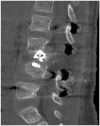The Use of Robotics Coupled With Navigation for Pediatric Congenital Spine Deformity
- PMID: 34539269
- PMCID: PMC8436341
- DOI: 10.1177/15563316211027166
The Use of Robotics Coupled With Navigation for Pediatric Congenital Spine Deformity
Abstract
Background: Spinal instrumentation in children with congenital spine deformity poses challenges to the surgeon, given the small patient size and the anomalous anatomy often encountered. Purpose: We aimed to investigate the accuracy of screw placement when robotics coupled with real-time navigation was used for surgical treatment of pediatric congenital spine deformity at 1 institution. Methods: We conducted a retrospective search of our institution's database for all patients younger than 18 years of age with congenital spine deformity who were treated with the robotics surgical platform coupled with navigation between June 2019 and December 2020. We recorded data on demographics, location and type of anomaly, procedure performed, and intraoperative variables related to robotics and navigation. We reviewed the images of patients who had intraoperative 3-dimensional imaging or postoperative computed tomographic scans to determine the accuracy of screw placement using the Gertzbein-Robbins scale. Results: In 14 patients identified, a total of 95 screws were attempted, with 94 successfully placed using robotics coupled with navigation. There were no noted screw-related complications (neurologic or visceral) and no return to the operating room for screw malposition. Conclusion: Patients with congenital spine deformity present potentially unique challenges due to variant anatomy. This retrospective series suggests that robotics coupled with navigation for congenital spine deformity correction in the pediatric population may aid in accurate screw placement and reduce complication rates. More rigorous study is warranted.
Keywords: congenital; pediatric; robotic-assisted navigation; scoliosis; spine deformity.
© The Author(s) 2021.
Conflict of interest statement
Declaration of Conflicting Interests: The author(s) declared no potential conflicts of interest with respect to the research, authorship, and/or publication of this article.
Figures






References
-
- Bastrom TP, Yaszay B, Shah SA, et al.. Major complications at two years after surgery impact SRS scores for adolescent idiopathic scoliosis patients. Spine Deform. 2019;7(1):93–99. - PubMed
-
- Devito DP, Kaplan L, Dietl R, et al.. Clinical acceptance and accuracy assessment of spinal implants guided with SpineAssist surgical robot: retrospective study. Spine (Phila Pa 1976). 2010;35(24):2109–2115. - PubMed
-
- Gertzbein SD, Robbins SE.Accuracy of pedicular screw placement in vivo. Spine (Phila Pa 1976). 1990;15(1):11–14. - PubMed
-
- Gonzalez D, Ghessese S, Cook D, Hedequist D. Initial intraoperative experience with robotic-assisted pedicle screw placement with stealth navigation in pediatric spine deformity: an evaluation of the first 40 cases [published online ahead of print October 22, 2020]. J Robot Surg. 10.1007/s11701-020-01159-3. - DOI - PubMed
LinkOut - more resources
Full Text Sources

